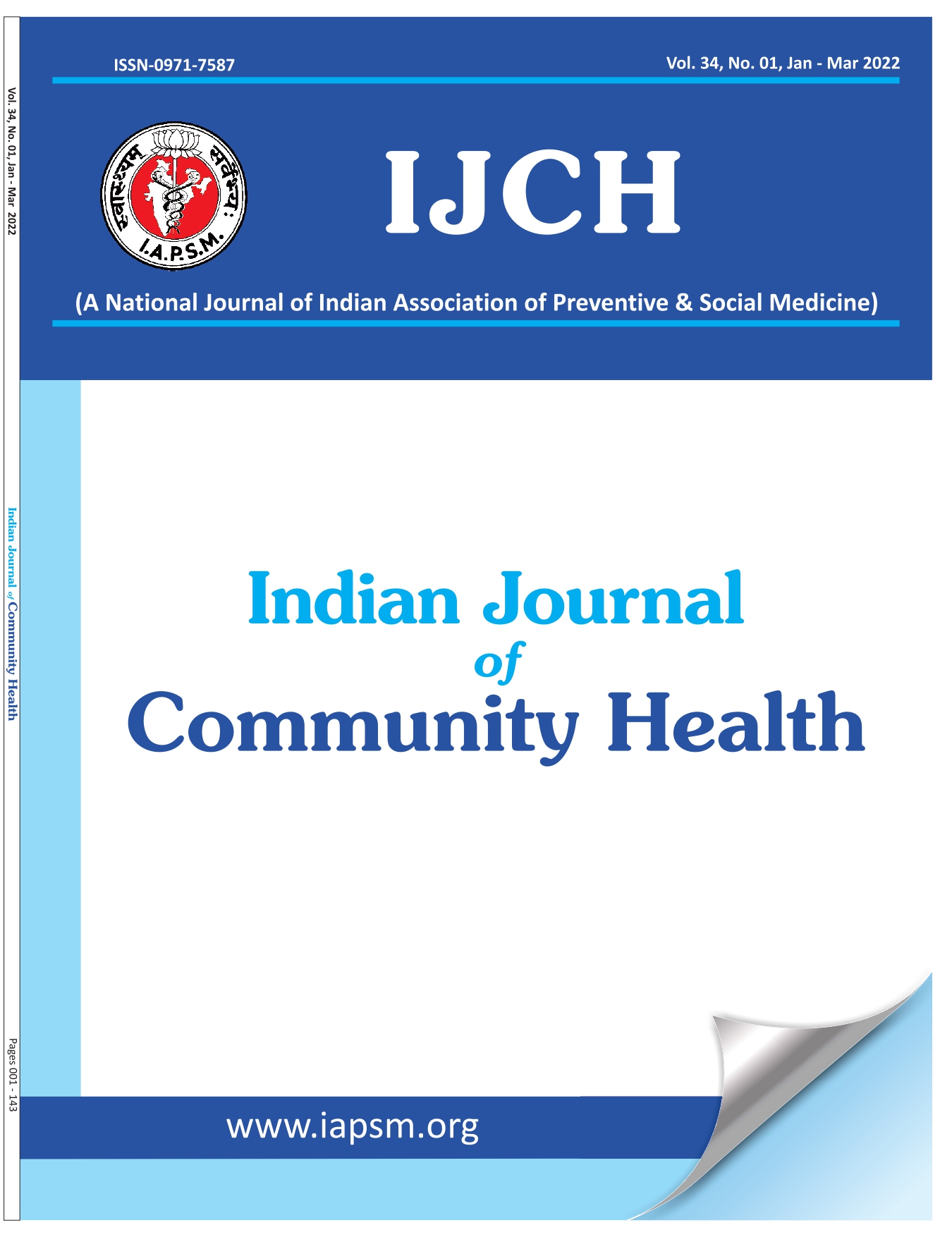Knowledge, Attitude and Practices Regarding Electronic Waste (e-waste) Management Among Users of Electronic Equipments Living in Lucknow City
DOI:
https://doi.org/10.47203/IJCH.2023.v35i01.008Keywords:
Humans, Electronic Waste, Cross-Sectional Studies, Hazardous Substances, Sample Size, Health Knowledge, Attitudes, Practice, Electronics, Surveys and Questionnaires, Software, TelevisionAbstract
Background: Contemporary society has led to the increasing use of electronic equipment that is very much responsible for the burden of electronic waste (e-waste). E-waste contains very hazardous substance that harms health and environmental conditions. There is no delicate mechanism for the management of e-waste in Lucknow city, Uttar Pradesh. This study assessed knowledge, practice, and awareness of e-waste management among residents of this city.
Material and methods: The study was conducted amongst users of electronic equipment living in the Lucknow City of Uttar Pradesh. The study was a Cross-sectional descriptive study. Multi-stage random sampling was done for the selection of participants for the study. A predesigned and pretested questionnaire was administered in a single setting for all phases. The total optimum sample size is 700 individuals who participated in the study. Data were entered in MS Excel 2016 and descriptive statistics such as frequencies and percentages were calculated, applying the chi-square test for association using R-4.2.1 Statistical software. Aim and objectives: To assess the knowledge, attitude and practices regarding the management of electronic waste among users of electronic equipment residing in Lucknow city.
Results: Only 37% of users are aware that e-waste adversely affects health. Only 34.3% of users knew that e-waste should be given to the seller or manufacturer for recycling while rest told that it should be stored at home, sold to a scrap dealer, or disposed with normal waste. 87.3% users are not aware about e-waste govt guidelines. In the current study electronic and print media like television, radio and news paper were not found to be source of information for e-waste disposal.
Conclusion: Education regarding the ill effects of e-waste is essential for people and awareness of proper disposal of e-waste is the need of the hour. Electronic and print media as well as companies producing electronic equipment should play a significant role to awaken the respondent about the disposal of e-waste.
Downloads
References
Arpitha VS, Patil PS. Knowledge, attitude, and practice of e-waste among medical students, Dharwad. Int J Med Sci Public Health 2020;9(8):488- 491. DOI: 10.5455/ ijmsph.2020.09147202011092020
Grant K, Goldizen FC, Sly PD, Brune MN, Neira M, van den Berg M, Norman RE. Health consequences of exposure to e-waste: a systematic review. The lancet global health. 2013 Dec 1; 1(6): e350-61. DOI: https://doi.org/10.1016/S2214-109X(13)70101-3
Subhaprada CS, Kalyani P. Study on awareness of e-waste management among medical students. International Journal of Community Medicine and Public Health. 2017 Feb; 4(2):506-10. DOI: https://dx.doi.org/10.18203/2394-6040. ijcmph20170281
Alam M, Bahauddin KM. Electronic waste in Bangladesh: Evaluating the situation, legislation and policy and way forward with strategy and approach. Present Environment and Sustainable Development. 2015;9(1):81–101.
Atiemo SM, Ofosu FG, Aboh IK, Kuranchie-Mensah H. Assessing the heavy metals contamination of surface dust from waste electrical and electronic equipment (e-waste) recycling site in Accra, Ghana. Res J Environ Earth Sci. 2012 May 15; 4 (5):605-11.
Forti V, Balde CP, Kuehr R, Bel G. The Global E-waste Monitor 2020: Quantities, flows and the circular economy potential. Available from: https://collections.unu.edu/view/UNU:7737
Where does e-waste end up? Available from: www.greenpeace. org/ international/en/ campaigns/ detox/electronics/the-e-waste-problem/where-does-e-waste-end-up accessed on 24/11/19.
Azodo AP, Ogban PU, Okpor J. Knowledge and Awareness Implication on E-waste Management among Nigerian Collegiate. Journal of Applied Sciences and Environmental Management. 2017; 21 (6):1035-40. DOI: 10.4314/jasem. v21i6.6
Afroz R, Masud MM, Akhtar R, Duasa JB. Survey and analysis of public knowledge, awareness and willingness to pay in Kuala Lumpur, Malaysia–a case study on household WEEE management. Journal of Cleaner Production. 2013 Aug 1; 52: 185-93. DOI: https://doi.org/10.1016/j.jclepro.2013.02.004
Alabi OA, Bakare AA. Genotoxicity and mutagenicity of electronic waste leachates using animal bioassays. Toxicological & Environmental Chemistry. 2011 May 1; 93(5):1073-88. DOI: https://doi.org/10.1080/02772248.2011.561949
Meem RA, Majumder AK, Bahauddin KM. Assessment of knowledge, attitude and practice (kap) of electronic waste management among consumers in Dhaka City, Bangladesh. GSC Advanced Research and Reviews. 2021 Aug 30; 8(2):126-35. DOI: https://doi.org/10.30574/gscarr.2021.8.2.0179
Saritha V, Sunil Kumar KA, Srikanth Vuppala NV. User attitudes and perceptions on electronic waste: An assessment. Pollution. 2015 Jan 1; 1(1): 31-43. DOI: https://jpoll.ut.ac.ir/ article_52178_5fd631841e2fcbb91c13964dd1ab750f.pdf
Borthakur, Anwesha, Sinha K. Electronic Waste Management in India: A Stakeholder’s Perspective. Electronic Green Journal. 2013; 1.36. DOI: https://doi.org/10.5070/G313618041
Joon V, Shahrawat R, Kapahi M. The emerging environmental and public health problem of electronic waste in India. Journal of Health and Pollution. 2017 Sep; 7(15):1-7. DOI: https://doi. org/10.5696/2156-9614-7.15.1
Borthakur A, Singh P. Understanding consumers’ perspectives of electronic waste in an emerging economy: a case study of New Delhi, India. Energy, Ecology and Environment. 2022 Jun; 7 (3):199-212. DOI: https://link.springer.com/ article/10.1007/s40974-022-00242-9
Chadwick H. Organizational research: Determining appropriate sample size. Information Technology and Performance Journal. 2001;19(1):43-50. Available from: https://www.opalco. com/wp-content/uploads/2014/10/Reading-Sample-Size1.pdf
Kish L. A procedure for objective respondent selection within the household. Journal of the American statistical Association. 1949 Sep 1; 44 (247):380-7. DOI: https://www.tandfonline. com/doi/abs/10.1080/01621459.1949.10483314
EWM-Rules-2016. Government of India Ministry of environment, Forest and Climate Change. Published in the Gazette of India, Extraordinary part –II, Section 3, Sub section (i). 2016 March 23. Available from: https://greene. gov.in/wp-content/uploads/2018/01/EWM-Rules-2016-english-23.03.2016.pdf
Pandey VK, Aggarwal P, Kakkar R. Modified BG prasad socioeconomic classification, update-2019. Indian journal of community health. 2019 Jan 1; 31(1).
Singh M, Thind PS, John S. An analysis on e-waste generation in Chandigarh: quantification, disposal pattern and future predictions. Journal of Material Cycles and Waste Management. 2018 Jul;20:1625-37.
Downloads
Published
How to Cite
License
Copyright (c) 2023 Peeyush Kariwala, S D Kandpal, Sumeet Dixit, Arvind Kumar Singh, Anurag Pathak, Shikhar Singh

This work is licensed under a Creative Commons Attribution-NonCommercial-NoDerivatives 4.0 International License.





